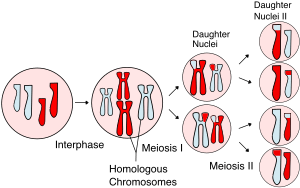Meiosis facts for kids
Meiosis is a special type of cell division. Unlike mitosis, the way normal body cells divide, meiosis results in cells that only have half the usual number of chromosomes, one from each pair. For that reason, meiosis is often called reduction division. In the long run, meiosis increases genetic variation, in a way which will be explained later.
Sexual reproduction takes place when a sperm fertilizes an egg. The eggs and sperm are special cells called gametes, or sex cells. Gametes are haploid; they have only half the number of chromosomes as a normal body cell (called a somatic cell). Fertilization restores the chromosomes in body cells to the diploid number.
The basic number of chromosomes in the body cells of a species is called the somatic number and is labelled 2n. In humans 2n = 46: we have 46 chromosomes. In the sex cells the chromosome number is n (humans: n = 23). So, in normal diploid organisms, chromosomes are present in two copies, one from each parent (23x2=46). The only exception are the sex chromosomes. In mammals, the female has two X chromosomes, and the male one X and one Y chromosome.
A karyotype is the characteristic chromosome number of a eukaryote species. The preparation and study of karyotypes is part of cytogenetics, the genetics of cells.
All eukaryotes that reproduce sexually use meiosis. This also includes many single-celled organisms. Meiosis does not occur in archaea or bacteria, which reproduce by asexual processes such as binary fission.
Details of meiosis
Meiosis can be divided into meiosis I and meiosis II.
Meiosis I
The function of the first division is to permit crossing over. Just like mitosis, meiosis includes prophase, metaphase, anaphase and telophase.
- Prophase I
- The chromosomes become visible, the nuclear envelope disappears and the centrioles (at the top and bottom of the nucleus) begin forming spindle fibres that envelop the chromosomes.
- At this stage each chromosome is split into two sister chromatids, held together by the centromeres. The paired chromosomes now have four chromatids (2 sets of 'sisters') pressed together. Crossing over takes place between two of the non-sister chromatids; the other two remain uncrossed. The crossover results in the exchange of segments of each of the participating chromatids, DNA and associated chromatin protein. Genetically, the process is called recombination.
- Metaphase I
- The chromosomes line up along the equatorial (the central line) of the spindle fibres in homologous pairs.
- Anaphase I
- The chromosomes are divided so that there are equal amounts on either side of the cell. As there are 46 chromosomes in a human cell, 23 end up on either side.
- (Cytokinesis, the division of cells into two, takes place. The cell divides.)
- Telophase I
- The two daughter cells are completely divided, a nucleic envelope forms and the chromosomes become less visible. There are 23 chromosomes in each of these cells.
Meiosis II
The two cells prepare to divide again in a stage known as interkinesis or interphase II. Both of these cells will go through meiosis II.
- Prophase II
- The chromosomes become visible, the nuclear envelope disappears and the centrioles form the spindle fibres.
- Metaphase II
- The chromosomes line up along the middle line on the spindle fibres
- Anaphase II
- The chromosomes get split into its two chromatids. Chromatids are the two strands of DNA (deoxyribo-nucleic acid) that make up the chromosome. They are joined by a mid-way connection called a centromere.
- (Cytokinesis takes place. The cell divides.)
- Telophase II
- The cells are completely divided. The nucleic envelope reforms and four new cells with different DNA are created.
In males, all four cells become sperm. In females, only one becomes a mature egg, while the remaining three become re-absorbed into the body.
Problems
In humans, there are certain conditions that are caused by meiosis gone wrong. Examples are:
- Down syndrome - trisomy of chromosome 21
- Patau syndrome - trisomy of chromosome 13
- Edwards syndrome - trisomy of chromosome 18
- Klinefelter syndrome - extra X chromosomes in males - i.e. XXY, XXXY, XXXXY
- Turner syndrome - lacking of one X chromosome in females - i.e. XO
- Triple X syndrome - an extra X chromosome in females
- XYY syndrome - an extra Y chromosome in males
Images for kids
See also
 In Spanish: Meiosis para niños
In Spanish: Meiosis para niños






